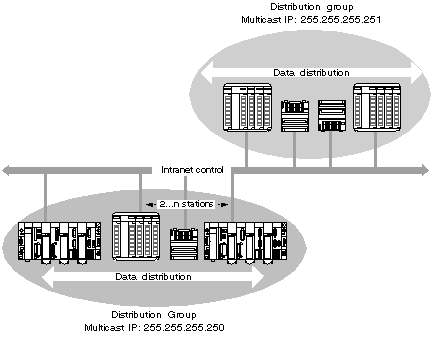The aim of the Global Data service, which is supported by Ethernet modules, is to provide an automatic data exchange for the coordination of PLC applications. Data is shared according to an inter-device publication/subscription method.
The communication modules are grouped into a Distribution group.
Each communication module publishes a local application variable for the other communication modules in the distribution group.
Each communication module can also subscribe to the application variables published by all other modules belonging to the distribution group.
The Global Data service should be configured to determine the location and the number of application variables of each communication module. Once the modules have been configured, exchanges between communication modules belonging to the same group are automatically carried out when the PLC is in RUN mode.
Illustration:
A Distribution group is a group of communication modules identified by the same multicast IP address. Exchanges in "multicasting" are used to distribute Global Data. Several independent distribution groups can co-exist on the same subnetwork with their own multicast address.
A Publication/Subscription protocol on UDP/IP is used for data distribution.
-
There is no theoretical limit to the number of stations that may belong to a distribution group. The main limitation is the number of variables exchanged in a group (64 variables).
-
Replacing a 140 NOE 771 x0 module by a new 140 NOE 771 x1 module, the Global Data Service must not be configured by web pages. Otherwise, the Global Data Utility will start even if Global Data has not been configured in the application.
